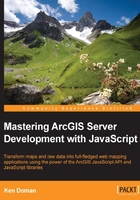
What this book covers
Chapter 1, Your First Mapping Application, introduces you to ArcGIS Server and the ArcGIS API for JavaScript. In this chapter, you will learn the basics of creating a map and adding layers.
Chapter 2, Digging into the API, gives an overview of the many API components, widgets, and features that are available within the ArcGIS API for JavaScript. This chapter offers explanations of how these components can be used.
Chapter 3, The Dojo Widget System, explores the Dojo framework, the comprehensive JavaScript framework the ArcGIS API for JavaScript is built in. This chapter explores the inner workings of Asynchronous Module Design (AMD) and how to build custom widgets for our mapping applications.
Chapter 4, Finding Peace in REST, examines the ArcGIS REST API, which defines how ArcGIS Server communicates with the application in the browser.
Chapter 5, Editing Map Data, covers how to edit geographic data stored in ArcGIS Server. This chapter examines the modules, widgets, and user controls provided by the ArcGIS JavaScript API.
Chapter 6, Charting Your Progress, looks at how you can convey map feature information through charts and graphs. The chapter not only discusses charts and graphs made with the Dojo Framework, but also looks at how to integrate other charting libraries, such as D3.js and HighCharts.js.
Chapter 7, Plays Well with Others, discusses ways to integrate other popular libraries into an application written with the ArcGIS API for JavaScript. This chapter also explores combining the framework with jQuery, Backbone.js, Angular.js, and Knockout.js.
Chapter 8, Styling Your Map, covers the use of CSS styling in the mapping application. This chapter examines how the Dojo framework lays out elements, and explores adding the Bootstrap framework to style the mapping application.
Chapter 9, Mobile Development, looks at the need to develop with mobile in mind and discusses the pitfalls of attempting to make your app "mobile-friendly". This chapter implements the dojox/mobile framework, provided by the Dojo framework, as a way to style elements for mobile use.
Chapter 10, Testing, discusses the need for test-driven and behavior-driven development. This chapter discusses how to test applications using the Intern and Jasmine testing frameworks.
Chapter 11, The Future of ArcGIS Development, looks at new mapping and application services such as ArcGIS Online and Web AppBuilder. You will learn how to develop an application around an ArcGIS Online webmap.